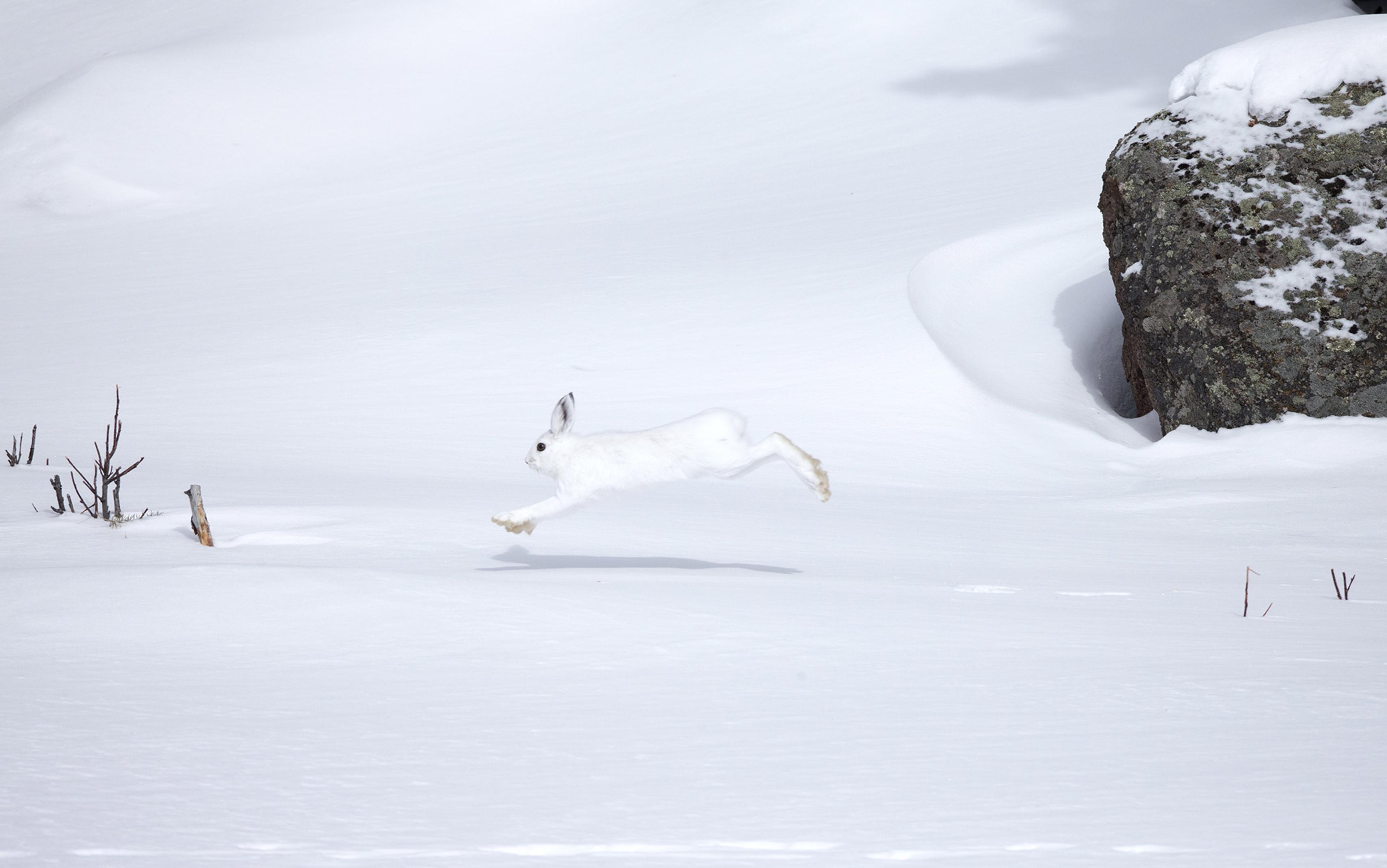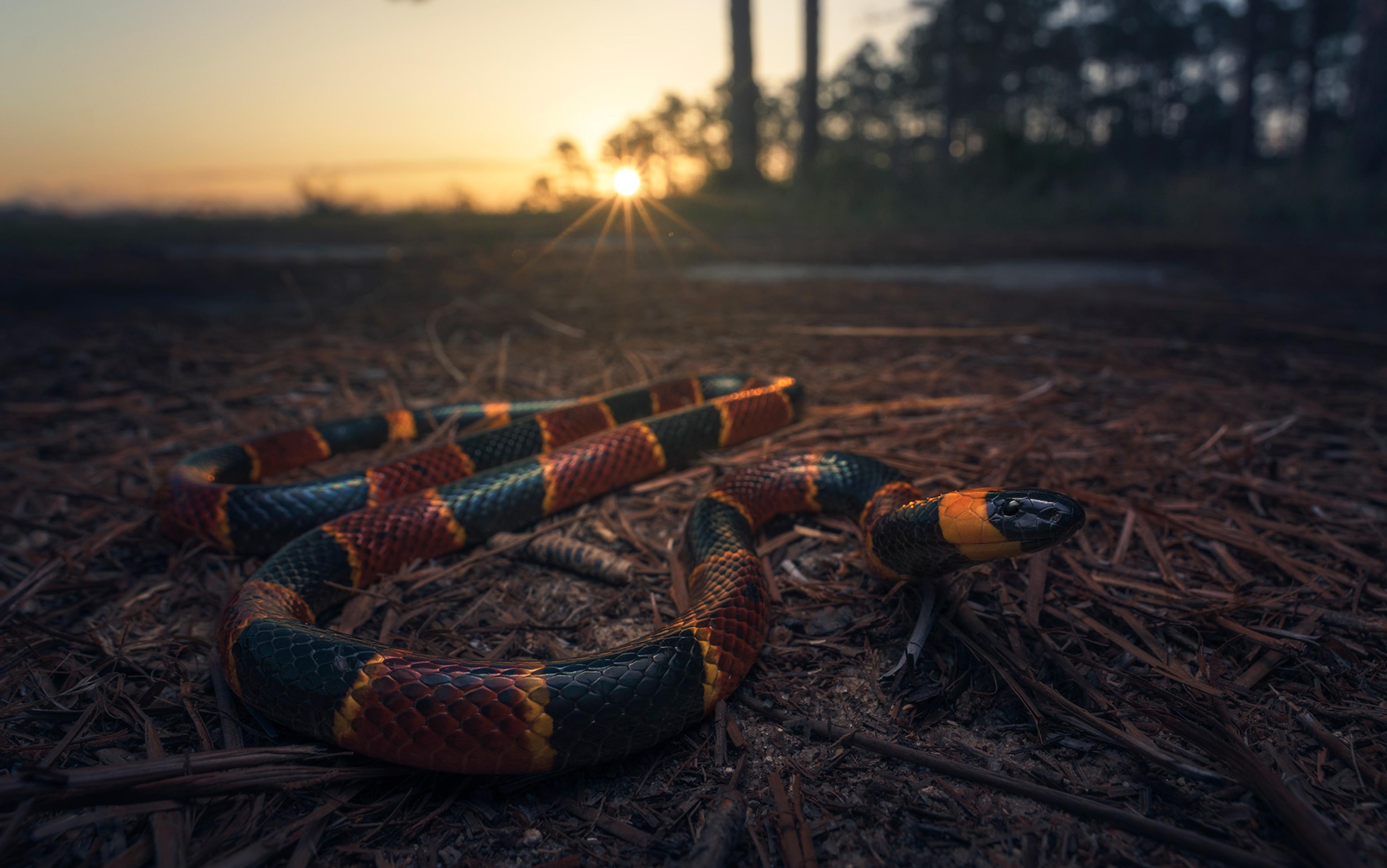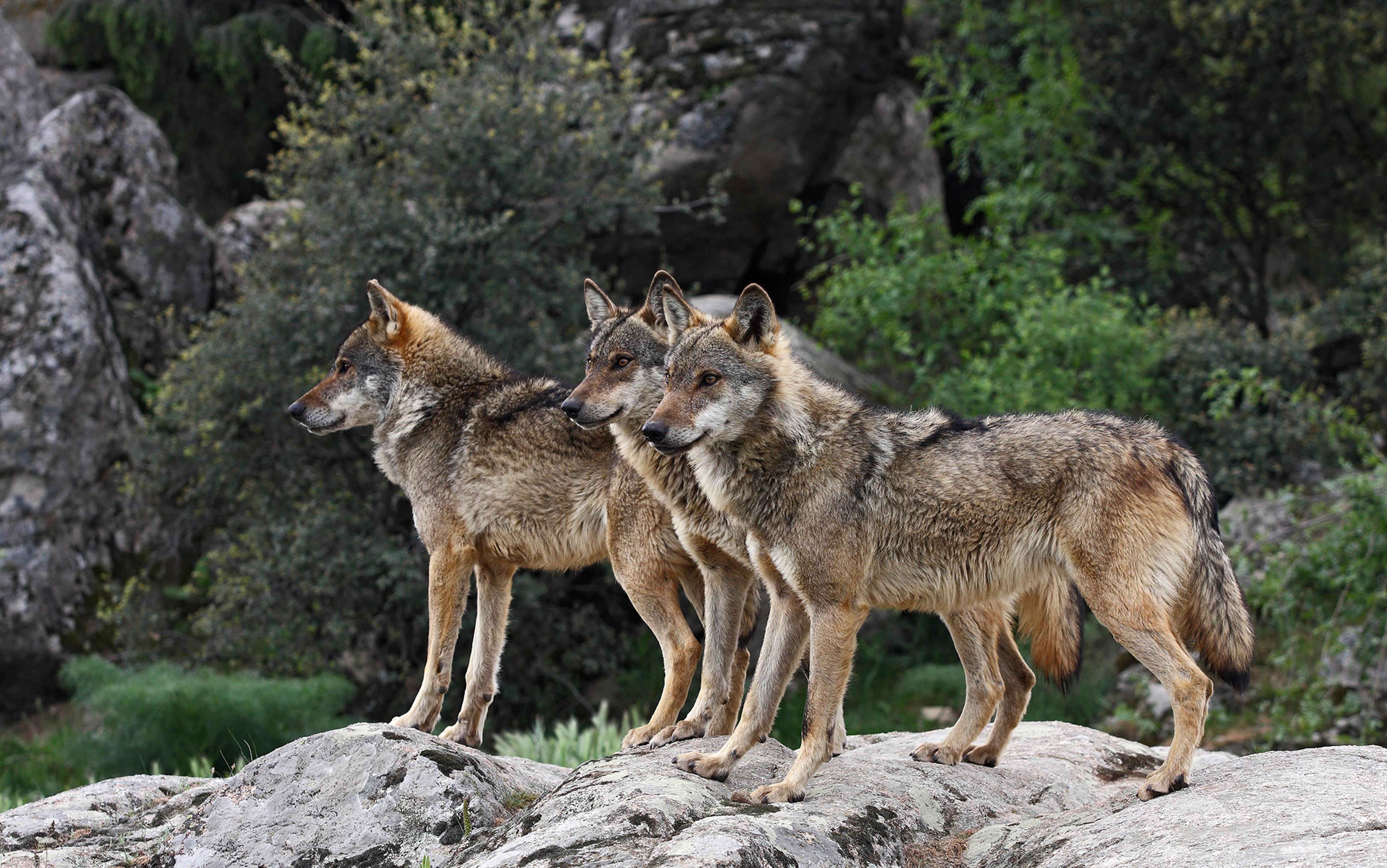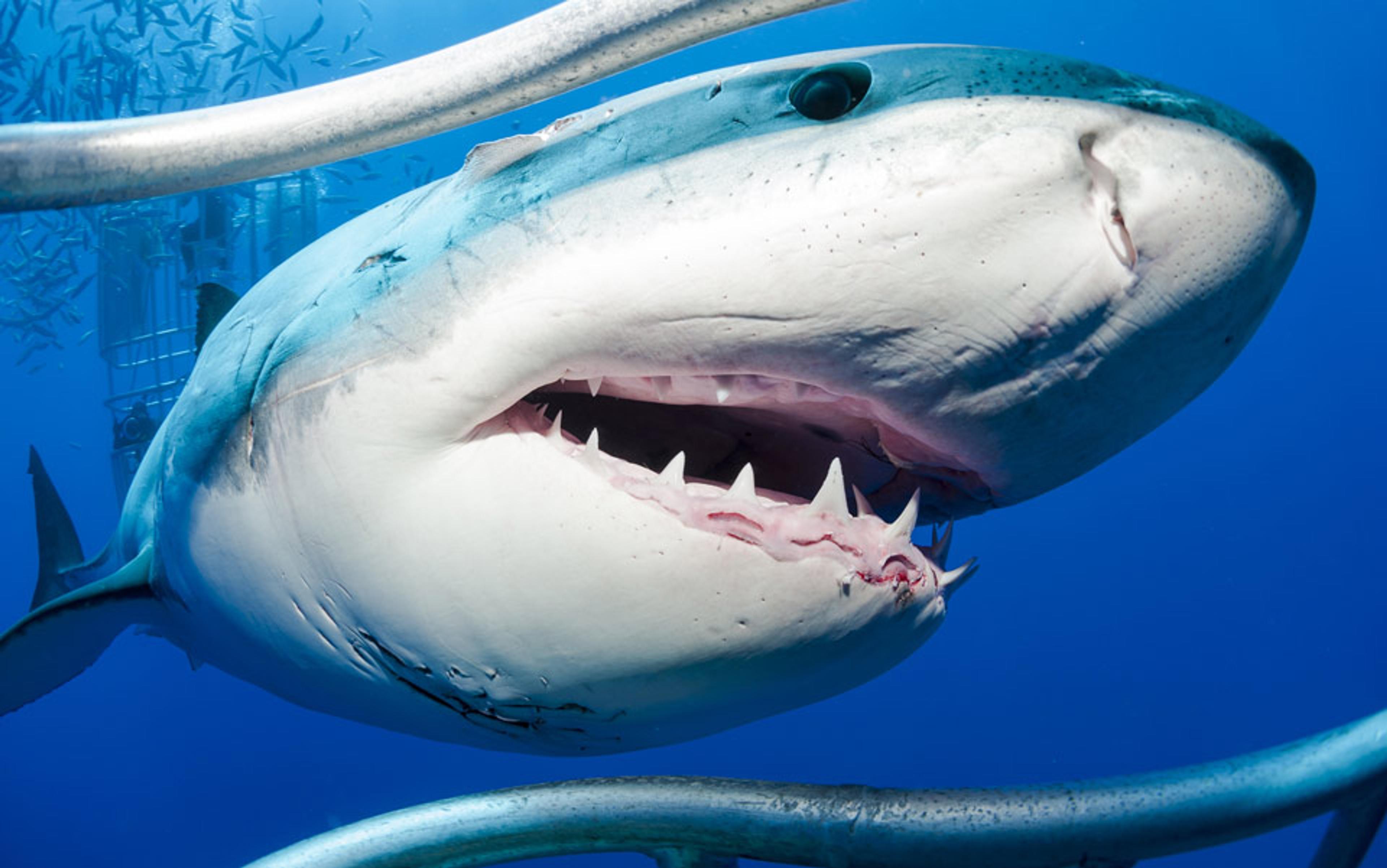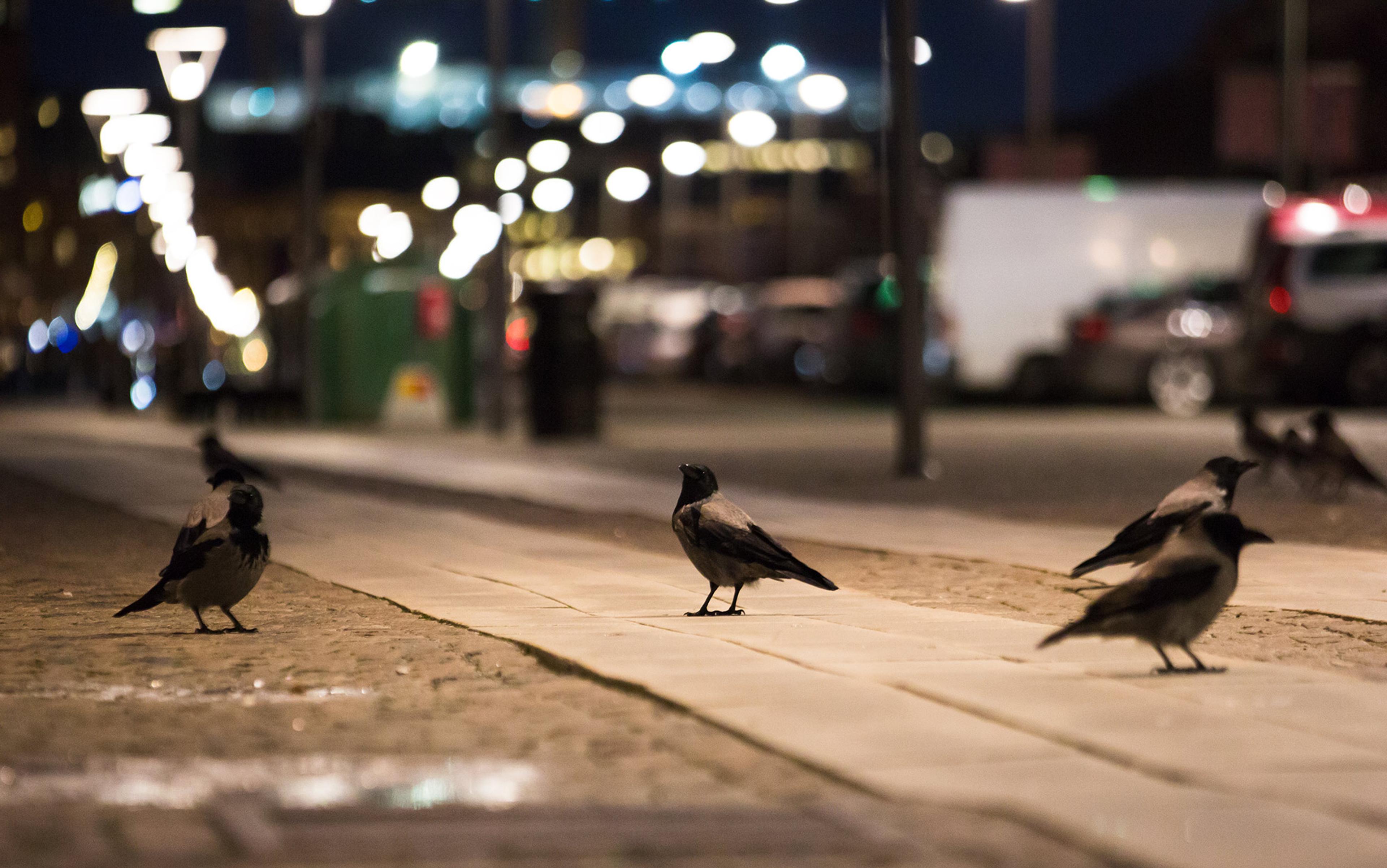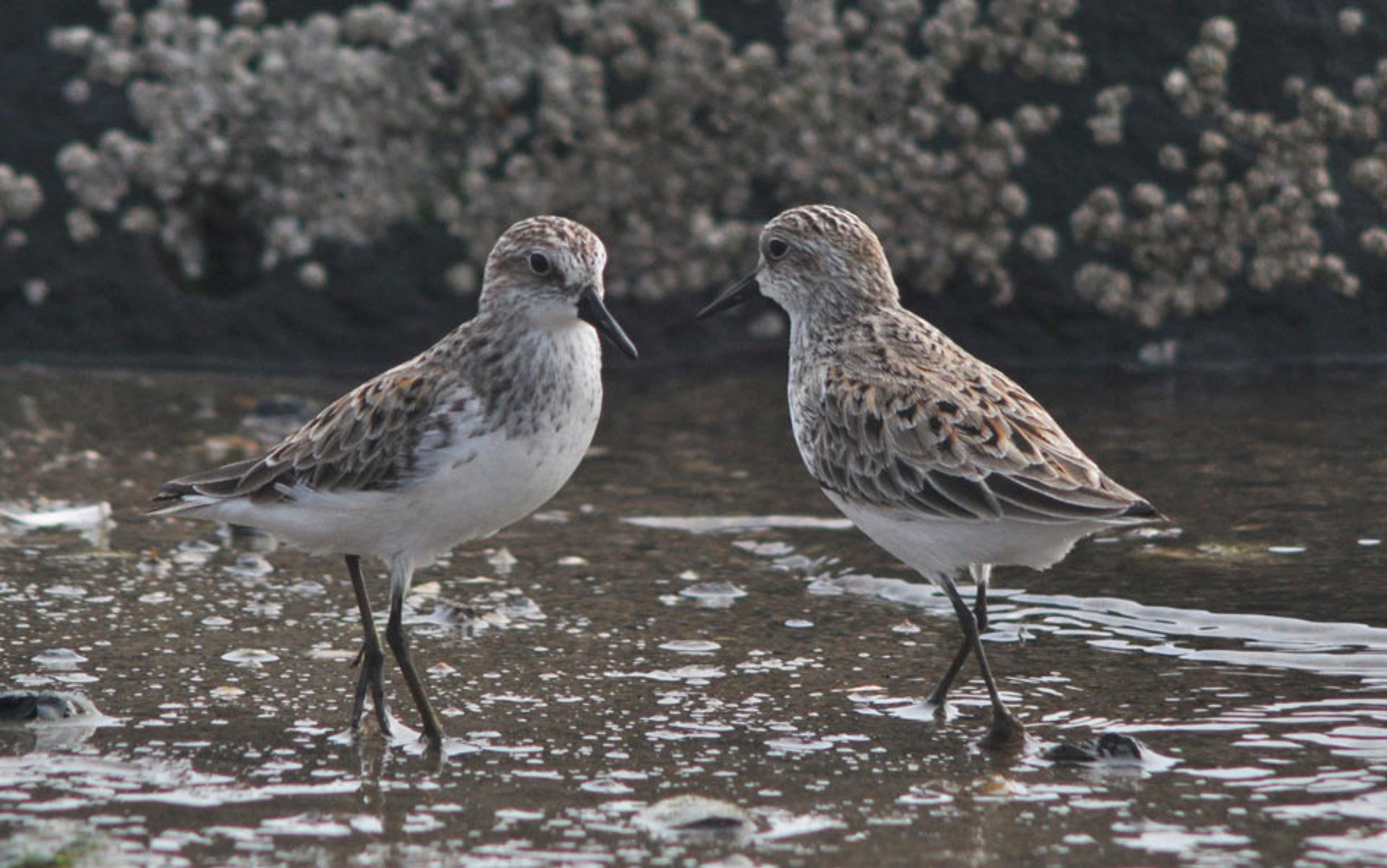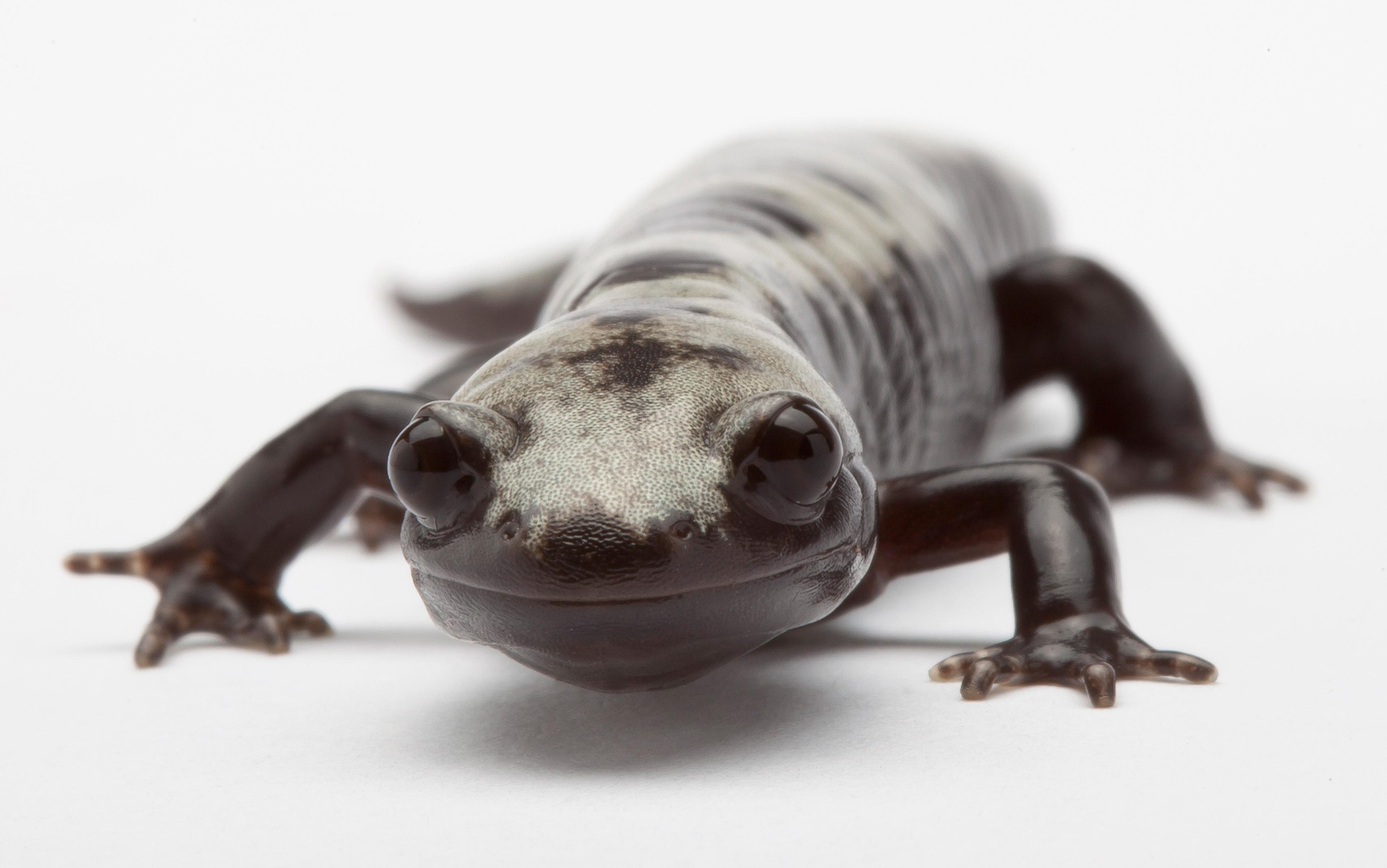As high tide inundates the muddy shallows of the Fraser river delta in British Columbia, what looks like a swarm of mosquitoes quivers in the air above. Upon closer inspection, the flitting mass turns out to be a flock of small shorebirds. The grey-brown wings and white chests of several thousand Pacific dunlins move in synchrony, undulating low over the water, then rising up like a rippling wave, sometimes for hours on end. Staying aloft like this is exhausting, especially in midwinter when the internal furnaces of these small birds, weighing less than a tennis ball, must be refuelled continuously. But setting down to rest and digest their mud-dug meals in the adjacent coastal marshes comes at a cost: an obscured, fearsome view of lurking predators like the skydiving peregrine falcon. The dunlins won’t alight until the ebbing tide buys them back their safer, open vistas.
The evidence that fear motivates dunlin flocking is circumstantial, but compelling. In the 1970s, when populations of peregrine falcons were depressed due to pesticides, dunlins spent less time flying and more roosting. But as pesticides such as DDT waned due to regulations, more peregrines have returned.
Fear is a powerful force not just for wintering dunlins, but across the natural world. Ecologists have long known that predators play a key role in ecosystems, shaping whole communities with the knock-on effects of who eats whom. But a new approach is revealing that it’s not just getting eaten, but also the fear of getting eaten, that shapes everything from individual brains and behaviour to whole ecosystems. This new field, exploring the non-consumptive effects of predators, is known as fear ecology.
Humans have long had a preoccupation with predators and the fear they instil. Models of one of Earth’s most successful predators – humans – have been fashioned into scarecrows for thousands of years to protect crops on land. Frightening deterrents have a history in the marine environment as well. To protect clam harvesting beds, Indigenous peoples such as the Nuu-chah-nulth Nation on the Pacific coast of Canada used dead sea otters anchored near the shore to scare these hungry shellfish-eating marine predators away.
Alongside the cultural practice of harnessing fear, perspectives on predators have undergone a fascinating transformation over time. Historically, as Euro-American immigrants moved across the continent during colonisation, dispossessing Indigenous peoples from the land, the dominant settler perception was that the best way to avoid livestock losses was through widespread predator eradication. So it was that anti-predator sentiment of the times saw the cougar, grizzly bear and grey wolf (Canis lupus) largely eliminated from wide swaths of North America, with wolf culling still practised and remaining a contentious issue today, alongside wolf reintroductions in many regions, including Yellowstone National Park.
Early in his career, even the noted conservationist, philosopher and writer Aldo Leopold (1887-1948) wanted to eradicate wolves, commenting at a conference in 1920 that ‘the last one must be caught before the job can be called fully successful’. Leopold later came to renounce that perspective, though modern historians suggest that the shift in his thinking was not the radical Eureka moment many have ascribed to his observation of a mother wolf dying after being shot. Nonetheless, Leopold and others began to notice the problems created when predators were gone. Leopold worried about the dramatic effect of overgrazing by deer on Vancouver Island in Canada, for example, once cougars and wolves were killed off. In his posthumously published book A Sand County Almanac (1949), he wrote that ‘the Yellowstone has lost its wolves and cougars, with the result that elk are ruining the flora, particularly on the winter range’ – thus weighing in on the fracas that continues to this day over the reintroduction of wolves (and fear) to Yellowstone.
It was during this historical era of widespread predator killing that mathematicians and biophysicists on both sides of the Atlantic began to tackle the ecologic underpinnings of predator-prey interactions. In nature, everyone needs to eat, from the few predators to the many prey and even more numerous plants. Thinking about the complex ways in which ecosystem puzzle pieces fit together, ecologists conceived of biological communities structured either from ‘top down’ or ‘bottom up’. Bottom-up communities are defined by an abundance of plants, for instance grass, available for grazing herbivores. Top-down thinking led to the idea of a ‘keystone predator’, a term first introduced in 1966 by the ecologist Robert Paine, who studied food webs in the rocky Pacific Northwest intertidal communities. There, the starfish Pisaster ochraceus is a top predator, keeping numbers of the mussels and barnacles it munches in check. Paine tested the keystone-predator idea via removal experiments. Starfish removal sparked dramatic changes, increasing competition between the species left behind, leading to fewer and fewer of them over time. A year later, nearly half of the 15 original species were gone. This and later studies underlined the disproportionately large role that keystone species play in maintaining the balance and biodiversity of communities.
Another fundamental shift in thinking about ecosystem functioning was the realisation that most of the time ‘predators really suck at what they do’, says Liana Zanette, an ecologist at Western University in London, Canada. With the majority of predator attacks unsuccessful, many animals have literally escaped the jaws of death. Near-death experiences give prey an opportunity to sharpen their survival skills for next time. That includes staying vigilant, which creates a starvation-predation trade-off – the dilemma facing the dunlins burning fuel in flight to avoid getting eaten by the peregrine. Prey cannot simultaneously search for food while keeping a watchful eye out for predatory danger.
Zanette and her research and life partner Michael Clinchy have carved out a career in studying the ecological effects of fear. Clinchy jokes that the duo makes a living from scaring wild animals. They do this mainly by using experimental manipulations. Studying fear effects is challenging because, as Zanette and Clinchy write in a recent overview article, ‘while one can see fear-related behaviours, and one can see a predator killing a prey, one cannot directly see fear reducing the reproduction or survival of prey, but must instead infer its effects’.
The idea that predators could have impacts going beyond direct mortality was the subject of a 1990 review paper by Steven Lima and Lawrence Dill, then at Simon Fraser University in Burnaby, British Columbia. They pushed behavioural scientists to consider that the nonlethal importance of predation was being underestimated. Later, in the 2000s, the idea that animals would behave and distribute spatially in response to predation risk became conceptualised as a ‘landscape of fear’. The current concept, fear ecology, focuses on how animals make decisions about what, where and when to eat, and how they forage and hunt for food.
Vigilance comes at the expense of other critical activities, such as eating. Scared prey eat less
One important natural laboratory for the ecological implications of fear is the Kluane Boreal Forest Ecosystem Project, a long-term study of the predatory lynx and its main prey, the snowshoe hare, in southwestern Yukon in Canada. In early work there, co-led by the ecologist Charles Krebs, researchers divided the forested habitat into square-kilometre blocks, comparing completely natural sites to those supplemented with food, fenced off from predators, or both. They found that food supplementation alone tripled snowshoe hare numbers. In blocks where predators such as lynx were excluded, hare numbers were double those of squares where predators had free range.
What the researchers expected, if the processes were simply additive, was that by combining food supplementation and predator exclusion, there would be five or six times as many hares. Instead, under these safer, food-rich conditions, there were 11 times as many. The results indicated that food and predators interacted synergistically, with some other behavioural, physiological or psychological factor mediating the hares’ ability to take advantage of the resource.
That something, it seems, was fear. It’s widely known that animals pause whatever they’re doing when they sense a predator around, Zanette explains. But vigilance comes at the expense of carrying out other critical activities, such as eating. Scared prey eat less.
Recent experiments suggest that prey can literally be scared to death. For instance, the ecologist Kirsty MacLeod, now at Lund University in Sweden, and collaborators including Krebs looked at the survival of pregnant female snowshoe hares captured and then housed in enclosures, where they were exposed to a simulated predator – a trained dog. This predator exposure, doing no physical harm to the hares, elevated their stress levels such that adult female survival dropped by 30 per cent and offspring survival to weaning dropped over 85 per cent.
In the early 2000s, Zanette and colleagues studied the dual effects of food and predation on the breeding success of song sparrows in the Gulf Islands of British Columbia. Comparing the breeding success of sparrows nesting on unaltered predator-rich mainland sites versus safer, small coastal island sites, they also altered food availability. Bird feeders were placed at half the sites so sparrows could get extra food. Song sparrows in the low-predator environment experienced 50 per cent better breeding success than those in the high-predator environment. With extra food available in the high-predator environment, birds did 50 per cent better as well. If these factors were additive, food additions to low-predator environments were expected to help birds do 100 per cent better. Instead, the combined effects of added food and lower predation meant that birds had 200 per cent better breeding success. Effects acted synergistically, like those seen for snowshoe hares.
This intriguing result sparked interest in quantifying the effects of fear alone by experimentally eliminating the opportunity for actual predation. To protect wild song-sparrow nests from predators, Zanette and Clinchy’s team used electric fences and netting. Then, recorded predator sounds were broadcast to manipulate fear exposure. With loudspeakers hung from trees, one cohort of sparrows heard 12 different predator calls including owls and raccoons. Another song sparrow group were played non-predator calls. Carefully peeking at nests and babies, they examined how sparrows responded.
In this experiment, published in Science in 2011, Zanette and collaborators discovered that sparrows protected from actual predation but scared by predator sounds produced 40 per cent fewer offspring over the breeding season. Cameras on the scene showed that actual predation didn’t occur.
Less songful sons were less likely to be successful breeders: fear can jump across generations
When mothers heard the predator calls alone, they were skittish, laid fewer eggs and produced fewer offspring. Of babies raised by these frightened parents, fewer survived. And for those that lived, food deprivation affected brain development.
In song sparrows, ‘it’s all about singing’, says Clinchy. Females find male song diversity sexy. But Zanette and Clinchy found that when sons were fed less by scared parents, their scrambled brains produced fewer songs in their repertoire. Less songful sons were less likely to be successful breeders, demonstrating that fear can jump across generations. The mechanisms that carry this fear message forward are still emerging, but evidence of intergenerational fear effects is being seen across a number of species, including birds, hares and humans.
Transgenerational effects of fear are seen in fish too. Alison Bell at the University of Illinois, Urbana-Champaign, has extensively studied fear in a small fish, the stickleback. A popular food for fish and birds, predation comprises most of their natural mortality. Bell has long been fascinated by how individual sticklebacks can show a range of different behaviours in the presence of predators. Adult sticklebacks, Bell knew from previous research, produce the stress hormone cortisol when near predators. To see if this affected the next generation, her lab exposed pregnant females to unpredictable predation cues from sham pikes and sculpins. Eggs and offspring of females chased by predators were compared with those from a control group, kept far from the fray. Fear treatments had myriad consequences, the team learned, including alterations to metabolism, learning and survival in the presence of predators throughout life.
Cortisol seemed to be the obvious messenger chemical, so they tested its effects. Radioactive tracing studies revealed that stickleback embryos did indeed take up cortisol from the environment. But within three days, embryos had kicked cortisol back out of the egg without metabolising it. So, in sticklebacks at least, the delivery mechanism for the fearful ‘message’ about predation risk remains elusive. ‘Our best guess as to the mechanism by which maternal predator exposure influences offspring is microRNA in eggs,’ says Bell. MicroRNA is a small RNA molecule involved in regulating gene expression, and support for this idea so far, notes Bell, is correlational. A new line of research led by Jennifer Hellmann, a postdoc in Bell’s lab, is investigating whether these transgenerational emergency alerts about predators might also come from fathers via sperm. Early indications from their ongoing experiments are that these ‘beware’ messages within sperm are just as prominent as those mediated via eggs.
Bell notes that the human biomedical literature about maternal stress is rife with evidence for negative impacts on offspring, such as cognitive deficits. But her research, and that of others, suggests that in a world of danger, stress caused by predator exposure can be a benefit – it prepares the young for living in a high-risk environment.
Zanette and Clinchy recently probed scared bird brains. In the lab, they first exposed chickadees either to the calls of predators such as hawks and owls or, alternatively, to the calls of non-predatory birds such as nuthatches and song sparrows. A week later, each chickadee was tested for its response to an alarm call – the sound made by scared chickadees. The researchers found that chickadees exposed to the scary predator sounds spent six times longer freezing in response to alarm calls compared with chickadees who heard only the unthreatening songs of nuthatches and sparrows.
In a subset of chickadees, they peered into the brain’s fear and memory centres. There they found some 50 per cent difference between treatments in the genetic transcription factor and chemical switch, DeltaFosB, which modifies genes, sometimes long-term. Even a week after exposure to the sounds, chickadees showed that they retained their fear memories, by freezing, yet again. The response to the alarm call a week after hearing predator sounds indicated that chickadees hadn’t just formed a memory of the specific predator: their amygdala and hippocampus had been primed to recognise their dangerous environment.
This chickadee work revealed PTSD-like behaviours and the same chemicals seen in lab rat and mouse brains in PTSD studies. Now, in Zanette and Clinchy’s ongoing fear experiments on two groups of cowbirds – one exposed to predators sounds, the other to non-predator sounds – changes inside the brain’s fear and memory centres (amygdala and hippocampus) a week after the sounds stopped suggest significantly less growth of new neurons in the brains of scared cowbirds. This suggests that scared cowbirds lock in fearful memories, suppressing growth of new neurons that might overwrite stored memories. Their work, which applies to wild or semi-wild birds the same protocols used on lab animals in human PTSD research, supports the idea that PTSD-like changes in the brain and behaviour might be the norm in nature.
The most fearful predators of all – humans – have an impact on other top predators
Fear has profound effects not only on individuals, but on whole communities too. In the Gulf Islands of British Columbia, between the city of Vancouver and Vancouver Island, Clinchy and Zanette explored the effects of fear on a whole intertidal community to see whether fear causes a trophic cascade – the ecological equivalent of a domino effect. On the west side of Vancouver Island, raccoons are mid-level predators, sharing habitat with apex predators such as cougars, bears and wolves, who pose a threat to racoons. But to the east of the main island, in the Gulf Islands, as Leopold noted, these predators are long extirpated, and raccoons have stepped up as ecological kingpins, now showing fear to domestic dogs only.
As a result, Gulf Island raccoons have radically changed their normally nocturnal habits. These raccoons have become bold daytime hunters, eating songbirds and feasting on intertidal seafood, ranging for kilometres out on exposed beaches with no places to hide. With nothing to fear, Gulf Island raccoons have been hammering bird populations and marine invertebrate species including worms, crabs and snails.
Zanette and Clinchy wondered what would happen to raccoons if an element of fear were restored. Broadcasting dog barks from some beaches and benign barking seals from others, they discovered that raccoons on barking-dog beaches, even after a month, spent less time feasting on seafood and more time being vigilant. Their finding suggests that restoring the fear of predators to a landscape through their sounds can have massive benefits for an ecosystem.
Recent studies reveal that the most fearful predators of all – humans – have an impact on other top predators, such as cougars. Now, Zanette and Clinchy, in collaboration with researchers in South Africa, are trying to see if broadcasting human sounds might help threatened species such as lions and rhinos avoid poachers.
Scientists no longer doubt that fear has profound implications. Evidence for fear effects on natural systems is mounting. ‘Getting at the true magnitude of the effect is really the next step,’ says Michael Peers of the University of Alberta in Edmonton, Canada.
What remains elusive in how predator fear affects prey is ‘not just fitness effects, but actual numbers’, says Michael Sheriff at the University of Massachusetts Dartmouth. Lots of research shows that predation risk affects survival and reproduction, things scientists refer to as fitness effects, he explains. He is part of a research group whose meta-analysis found a dearth of evidence that predator fear affects population size. ‘This is a key chunk that we’re missing,’ he says. He also suggests that a fruitful avenue for future research is to get beyond studying dyadic, two-species predator-prey interactions and dive deeper into the complexity of how predator fear affects whole communities.
One of the weaknesses of fear experiments to date, as identified by Sheriff and others, is their artificial design. Many different stand-ins for predator presence have been used to study fear effects including sounds, smells and visual models such as fake fish, and trained dogs as stand-ins for coyotes. However, ‘it’s really difficult to know how much these [fear] cues that are applied [in experiments] occur naturally in the environment,’ says Peers, who is part of a new generation of scientists learning from scared hares in Kluane. He notes that fear stimuli in recent experiments typically focus on one sensory modality only, and are measured without the possibility of prey actually being killed. These are artificial situations, he cautions and, in an article in the journal Ecology, Peers and 10 co-authors underline that such artifice might lead to overestimating the consequences of fear in natural populations.
The magnitude with which fear ripples through ecosystems and whether or not simulated experiences reflect real-world circumstances are subjects likely to stir continued debate. But it’s not just ecosystems and endangered species that could benefit when we understand more about the ecology of fear. There is a growing cross-disciplinary realisation that increased communication between fear ecologists and medical scientists might help us to better understand human PTSD and the transgenerational effects of trauma too.
Like the dunlins weaving back and forth, diving up and down over the tide-flooded estuary, our understanding of the impact of fear on individual brains, populations, communities and ecosystems has taken flight, changing course while moving forward.
Parts of this essay were first reported in the journal BioScience.
